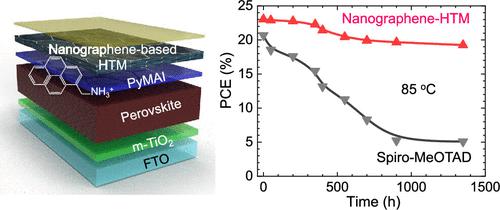当前位置:
X-MOL 学术
›
ACS Energy Lett.
›
论文详情
Our official English website, www.x-mol.net, welcomes your
feedback! (Note: you will need to create a separate account there.)
Nanographene Coupled with Interfacial Pyrene Derivatives for Thermally Stable Perovskite Solar Cells
ACS Energy Letters ( IF 19.3 ) Pub Date : 2023-04-17 , DOI: 10.1021/acsenergylett.3c00262 Seul-Gi Kim 1, 2 , Thybault de Monfreid 3 , Jeong-Hyeon Kim 2 , Fabrice Goubard 3 , Joseph J. Berry 4, 5, 6 , Kai Zhu 1 , Thanh-Tuân Bui 3 , Nam-Gyu Park 2, 7
ACS Energy Letters ( IF 19.3 ) Pub Date : 2023-04-17 , DOI: 10.1021/acsenergylett.3c00262 Seul-Gi Kim 1, 2 , Thybault de Monfreid 3 , Jeong-Hyeon Kim 2 , Fabrice Goubard 3 , Joseph J. Berry 4, 5, 6 , Kai Zhu 1 , Thanh-Tuân Bui 3 , Nam-Gyu Park 2, 7
Affiliation

|
Although high-efficiency perovskite solar cells (PSCs) have been achieved using a hole-extracting material, spiro-MeOTAD, thermal stability has been unattainable due to the low glass transition temperature of spiro-MeOTAD and additives therein. Here, we report on the use of nanographene-based hole-transporting materials coupled with a pyrene derivative as an interface modifier for thermally stable and high efficiency PSCs. Asymmetric methyl and methoxy groups are introduced in the diphenylamino group that is attached to the hexa-peri-hexabenzocoronene (HBC) nanographene core, coded HBC-DPAMeOMe. 1-Pyrenemethylammonium iodide is coupled to enhance the chemical interaction between perovskite and HBC-DPAMeOMe, which leads to a power conversion efficiency over 23%. A thermal stability test at 85 °C for 1000 h reveals that 83.6% of the initial efficiency (23.04% → 19.25%) is maintained for the device with HBC-DPAMeOMe, while a significant degradation from 20.69% to 5.08% is observed for the device with spiro-MeOTAD. Nanographene-based hole conductors shed light on the thermal stability issue in PSCs.
中文翻译:

纳米石墨烯与界面芘衍生物偶联用于热稳定钙钛矿太阳能电池
尽管已经使用空穴提取材料 spiro-MeOTAD 实现了高效钙钛矿太阳能电池 (PSC),但由于 spiro-MeOTAD 及其添加剂的玻璃化转变温度较低,热稳定性一直无法实现。在这里,我们报告了使用基于纳米石墨烯的空穴传输材料与芘衍生物作为热稳定和高效 PSC 的界面改性剂。不对称甲基和甲氧基被引入连接到六周位的二苯基氨基中-六苯并萘 (HBC) 纳米石墨烯核,编码为 HBC-DPAMeOMe。偶联 1-芘甲基碘化铵可增强钙钛矿和 HBC-DPAMeOMe 之间的化学相互作用,从而使功率转换效率超过 23%。在 85 °C 下进行 1000 小时的热稳定性测试表明,使用 HBC-DPAMeOMe 的设备保持了 83.6% 的初始效率(23.04% → 19.25%),而观察到从 20.69% 显着下降到 5.08%带有 spiro-MeOTAD 的装置。基于纳米石墨烯的空穴导体揭示了 PSC 中的热稳定性问题。
更新日期:2023-04-17
中文翻译:

纳米石墨烯与界面芘衍生物偶联用于热稳定钙钛矿太阳能电池
尽管已经使用空穴提取材料 spiro-MeOTAD 实现了高效钙钛矿太阳能电池 (PSC),但由于 spiro-MeOTAD 及其添加剂的玻璃化转变温度较低,热稳定性一直无法实现。在这里,我们报告了使用基于纳米石墨烯的空穴传输材料与芘衍生物作为热稳定和高效 PSC 的界面改性剂。不对称甲基和甲氧基被引入连接到六周位的二苯基氨基中-六苯并萘 (HBC) 纳米石墨烯核,编码为 HBC-DPAMeOMe。偶联 1-芘甲基碘化铵可增强钙钛矿和 HBC-DPAMeOMe 之间的化学相互作用,从而使功率转换效率超过 23%。在 85 °C 下进行 1000 小时的热稳定性测试表明,使用 HBC-DPAMeOMe 的设备保持了 83.6% 的初始效率(23.04% → 19.25%),而观察到从 20.69% 显着下降到 5.08%带有 spiro-MeOTAD 的装置。基于纳米石墨烯的空穴导体揭示了 PSC 中的热稳定性问题。































 京公网安备 11010802027423号
京公网安备 11010802027423号